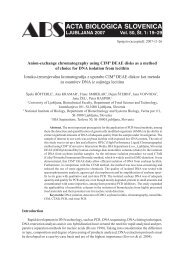ACTA BIOLOGICA SLOVENICA - ZRC SAZU
ACTA BIOLOGICA SLOVENICA - ZRC SAZU
ACTA BIOLOGICA SLOVENICA - ZRC SAZU
You also want an ePaper? Increase the reach of your titles
YUMPU automatically turns print PDFs into web optimized ePapers that Google loves.
36 Acta Biologica Slovenica, 52 (2), 2009<br />
various prokaryotic organisms: cyanobacteria,<br />
various proteobacteria, and archaea. The more<br />
they are investigated, the more the diatoms appear<br />
as heaps of disconnected twigs from the<br />
great tree of evolution. Animals, fungi, and some<br />
microorganisms have, based on their molecular<br />
biology, been grouped together under the heading<br />
Opisthokonta, a rather thick branch on the tree<br />
of evolution. Scala et al. (2002) found as many<br />
genes in the diatom Phaeodactylum tricornutum<br />
being closely related to opisthokont genes as being<br />
related to genes in higher plants.<br />
In contrast to chloroplasts of plants and green<br />
algae, which are surrounded by two membranes,<br />
there are four membranes around the chloroplasts<br />
of diatoms. This is understandable, as these<br />
chloroplasts have originated by two successive<br />
endosymbiotic events. Between the membranes<br />
one can in some cases find a »nucleomorph«, the<br />
remains of the nucleus of the engulfed red alga.<br />
The nucleomorph contains very few genes, but<br />
those that exist are typical chloroplast genes.<br />
Motility, carbon assimilation,<br />
reproduction, and technical applications<br />
One might think that diatoms, enclosed in<br />
glass jars as they are, would not be able to move<br />
actively. But for a long time people have studied<br />
how pennate diatoms can creep over a substratum,<br />
and now it is known that many centric diatoms<br />
possess this ability, too (sat o & Me D l i n 2006).<br />
Some diatoms leave a mucus track behind, as<br />
snails do, and it is thought that their movement<br />
is somehow connected to this slime exudation.<br />
The mucus exits through a slit called a raphe in<br />
the middle of one or both halves of the frustrule<br />
(silica enclosure). The slime is set in motion by<br />
microfibrils which inside the cell are connected<br />
to filaments of actin and myosin, the same kinds<br />
of protein molecules that we have in our muscles<br />
(Be rt r a n D 2008). This view is, however, partly<br />
based on speculation, and slime trails are not to<br />
be seen after individuals of all species of motile<br />
diatoms. The movements are regulated by, among<br />
other things, various light-perceiving systems.<br />
Cells with a raphe can move with up to 25 µm s –1 ,<br />
but some species without a raphe can also move,<br />
albeit at a slower speed, about 1 µm s –1 .<br />
One might also imagine that it would be<br />
difficult for the armor-enclosed diatoms to take<br />
up carbon dioxide or bicarbonate ions for their<br />
photosynthesis, but they are, in fact, very efficient<br />
in doing this. The pretty perforations in<br />
the frustrules contribute to this, and some species<br />
are able to carry out both C3-photosynthesis with<br />
incorporation of carbon dioxide into 3-phosphonolglycerate,<br />
and C4-photosynthesis with incorporation<br />
of bicarbonate into oxaloacetate (review<br />
by roB e rt s & al. 2007). Contributing to the<br />
efficient uptake of inorganic carbon is also an<br />
exudation of extracellular carbonic anhydrase,<br />
enabling a rapid interconversion between carbon<br />
dioxide and bicarbonate. Diatoms are unusual in<br />
that they have a carbonic anhydrase which can<br />
use cadmium instead of zinc without decrease<br />
in activity (str a s D e i t 2001; Xu & al. 2008),<br />
which is very useful as zinc is depleted from the<br />
ocean surface. Cadmium can often replace zink<br />
in enzymes, but usually with a large decrease or<br />
complete loss of activity.<br />
The two halves of a diatom are of unequal<br />
size and form a box with lid (Figure 3). When<br />
cells divide, each daugher cell gets one half, and<br />
then forms a new half inside the existing one.<br />
Therefore one daughter cell will be of the same<br />
size as the original cell, while the other one will<br />
be smaller. With repeated divisions smaller and<br />
smaller cells will be created, and when a size of<br />
about one third of the original one has been reached<br />
meiosis takes place and sex cells (gametes) with<br />
half the number of chromosomes result. They can<br />
be of equal size, or half of them can be smaller and<br />
act as sperm cells, depending on the systematic<br />
position of the species. After fusion of gametes<br />
the resulting cell grows to the size we started the<br />
story with, and only then is a continuous silica<br />
enclosure produced again.<br />
Diatoms have a long story of technical uses.<br />
The most well-known one from a Swedish perspective<br />
is as component in Alfred Nobel’s dynamite, a<br />
mixture of diatom frustrules and glyceryl trinitrate<br />
(»nitroglycerine«). Diatom frustrules have also<br />
been used in toothpaste, but this use is declining<br />
since they are so hard that they damage the enamel<br />
of the teeth. By their ability to form patterns in<br />
silica (silicon dioxide) the diatoms have attracted<br />
interest in the field of nanotechnology (Bo z a rt H &<br />
al. 2009). One is more interested in understanding



